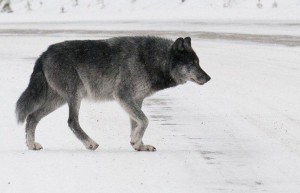
Living in Jasper National Park, we know people come and go, moving in and out of town with the seasons. Did you know that the same thing happens with Jasper’s wolves?
Wolf numbers are dynamic with pups being born, adults leaving or new ones arriving, territories shifting, packs dissolving or new packs forming. Ongoing monitoring of Jasper’s wolves helps us assess the number of wolves in the park and how they use the landscape throughout the year.
As a predator of woodland caribou, this information can assist Jasper’s caribou recovery program.
With their shifting pack dynamics and large territories across the park, wolf monitoring isn’t easy. Two key technologies are being used to gather information on Jasper’s wolf packs: radio collars and remote cameras.
A GPS-equipped wolf collar records the animals location points every one to 13 hour(s). The collars manually or automatically release before they are retrieved and the data is collected. The information is collected over one year, giving a clear picture of where that wolf and its pack have been spending time in the park.
To maintain knowledge of dynamic wolf biology and their use of the park landscape, we aim to maintain collars in a few key packs. Last week, a highly specialized capture crew was in Jasper and successfully collared a black wolf in the Sunwapta pack.
Collared wolves only account for a small number of the overall population in Jasper. By supplementing this information with remote camera images from throughout the park, we get a more thorough idea of pack sizes, park-wide wolf numbers, and where the wolf packs exist.
Combined with the GPS collar data, this information supports better understanding of the wolf that aids in decision-making and analysis of caribou conservation actions.
Wolves and caribou
One of the essential qualities of good caribou habitat is a low number of predators.
In the mountains, very few animals spend their winters at high elevation. With deep snow and little food, even wolves rarely venture into these areas, resulting in an ideal situation for caribou.
Wolf research in and outside of the park has shown that wolves will use packed trails in winter, travelling faster and venturing farther into caribou habitat.
To support caribou recovery in Jasper National Park, all areas of important winter habitat have access delayed until late winter. This reduces the risk of having predators venture into these areas, maintaining the habitat quality that caribou need.
Even one track can increase the risk to declining caribou herds in the park. Please help support caribou recovery by taking advantage of the other fine areas for winter recreation that are available until these areas reopen in late February.
For trip planning assistance, visit the Jasper Information Centre or the Jasper National Park webpage at www.parkscanada/jasper.
Living with wolves
Hearing wolves howling in the distance or catching a glimpse of one of these elusive animals is a truly magical experience. As winter dawns in the mountains, the wolves’ primary prey (deer, elk and moose) descend to the valleys where there is more food and less snow.
Following their prey into the valleys, winter often brings wolves closer to people. Tracks in the snow offer a stark reminder that we share the landscape with wolves, even if we never see them.
As you venture out to enjoy the winter sunshine, whether on foot, skis, skates or tires, remember these simple tips to help protect wolves, people and dogs.
Travel smart and be prepared: be aware of your surroundings, closely supervise small children, carry bear spray, and avoid travel at dusk and dawn when predators are most active.
Keep dogs on-leash: repeated encounters between wolves and dogs not only put wolves at risk but also increases risk to future people and dogs travelling in the same area.
Report wolf sightings or encounters: this is key to help ensure your safety and protect wolves. Call 780-852-6155 or anonymously call 1-877-852-3100.
